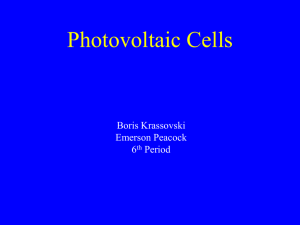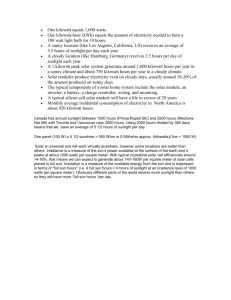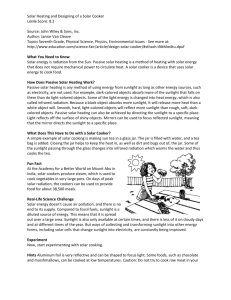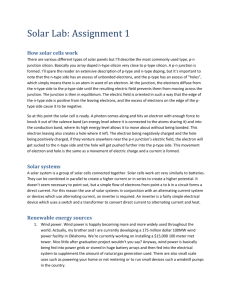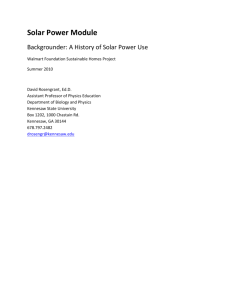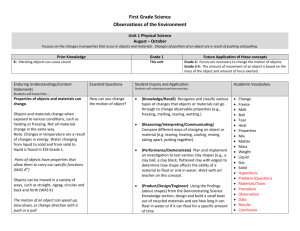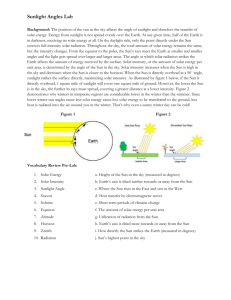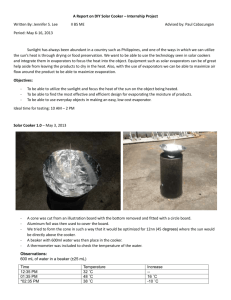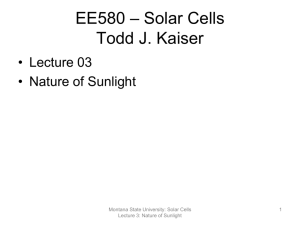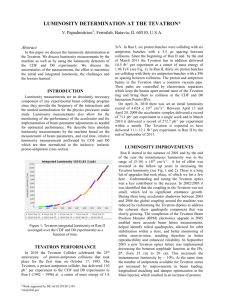Astrophysics Experiment
advertisement
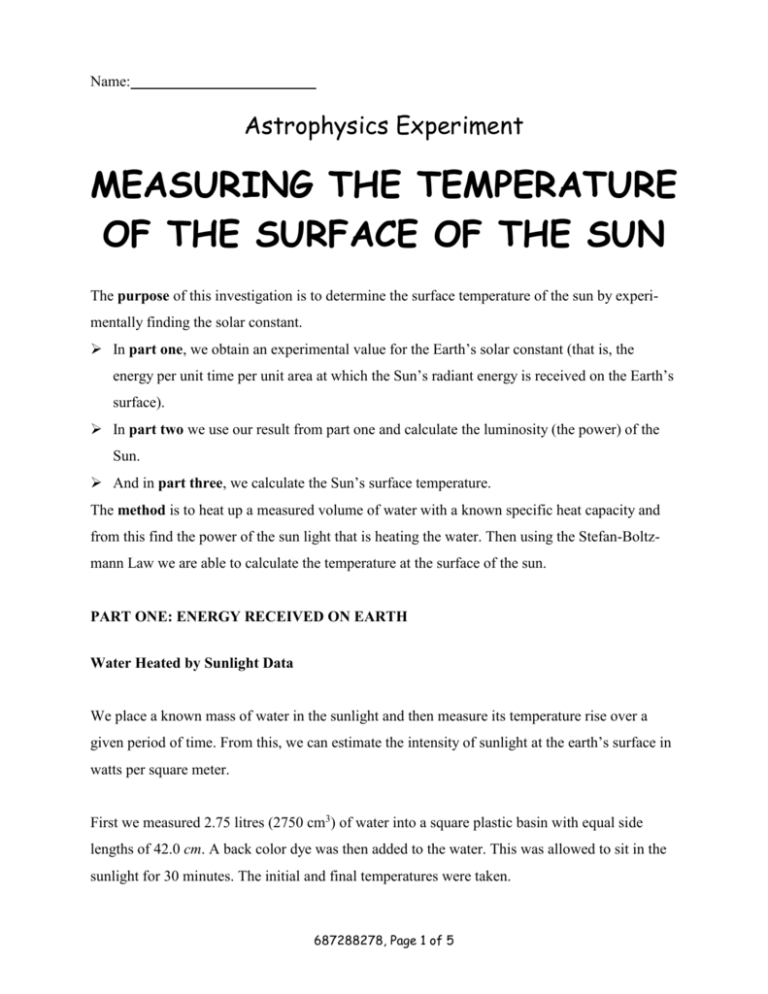
Name: Astrophysics Experiment MEASURING THE TEMPERATURE OF THE SURFACE OF THE SUN The purpose of this investigation is to determine the surface temperature of the sun by experimentally finding the solar constant. In part one, we obtain an experimental value for the Earth’s solar constant (that is, the energy per unit time per unit area at which the Sun’s radiant energy is received on the Earth’s surface). In part two we use our result from part one and calculate the luminosity (the power) of the Sun. And in part three, we calculate the Sun’s surface temperature. The method is to heat up a measured volume of water with a known specific heat capacity and from this find the power of the sun light that is heating the water. Then using the Stefan-Boltzmann Law we are able to calculate the temperature at the surface of the sun. PART ONE: ENERGY RECEIVED ON EARTH Water Heated by Sunlight Data We place a known mass of water in the sunlight and then measure its temperature rise over a given period of time. From this, we can estimate the intensity of sunlight at the earth’s surface in watts per square meter. First we measured 2.75 litres (2750 cm3) of water into a square plastic basin with equal side lengths of 42.0 cm. A back color dye was then added to the water. This was allowed to sit in the sunlight for 30 minutes. The initial and final temperatures were taken. 687288278, Page 1 of 5 The following data was obtained. Mass of Water: mw 2750 cm2 1g / cm 2 2750g 2.750 kg with a volume uncertainty 2 of V 1cm Surface Area: A l 2 0.420 m 0.1764 m2 with a length uncertainty l 0.1cm Initial Temperature: Ti 26.5 0.5 and the Final Temperature: Tf 47.0 0.5 Time Interval: T 30.0min 60s / min 1800 2 s Specific Heat Capacity of Water: cw 4186 J kg1 K 1 2 It is estimated that the final results will be significantly off; therefore uncertainties will not be carried through the calculation. Other factors will be significant here, such as the angle of the sun on the water dish, the weather conditions (partly cloudy sky), upper atmosphere absorption, etc. Analysis *The energy received by the water over the 30 minute interval is…..? *This is equivalent to a heating power of….? *The power per unit area (also known as the Earth’s solar constant) is then calculated to be….? Results From above, we see that the experimental value of the solar constant is * 2 . The accepted value or textbook value of the solar constant is 1.39 kWm . This is about double our experimental value. 687288278, Page 2 of 5 Conclusion 11 The Earth has a mean orbital radius about the Sun of 1.496 10 m . The Sun’s radiation spreads out over the surface of a sphere of this radius. *So, the flux (the power received per unit area), given the textbook value, PSun 3.8 10 26 W , is calculated to be….? Hence we can say that each square meter of the Earth’s surface receives * Joules of energy from the Sun every second. This value is for the top of the atmosphere, of course. And the atmosphere is a good absorber of radiation, and in fact only about 1000 watts of power per square meter reaches the ground level. Therefore our experimental value of * W is about 25% low from what we might get. There are various factors which account for this difference. *Can you list them? PART TWO: THE SUN’S POWER Using the experimental value of the Earth’s solar constant, * , the known mean dis- tance between the Earth and Sun, 1.496 1011m , *we can calculate the Sun’s total radiated power, the Sun’s luminosity, as follows. b L L b 4 d2 2 4 d Lexperimental value of power = Laccepted value of power = 3.8 x 1026 W Our experimental value is low, as expected, but it is the correct magnitude, and this is a respectable result. 687288278, Page 3 of 5 PART THREE: THE SUN’S SURFACE TEMPERATURE To calculate the Sun’s surface temperature we use the Stefan’s-Boltzmann Law. Here we require the experimental value of the solar constant and several other values and constants that are found in textbooks. 11 Mean distance between Earth and Sun: d 1.496 10 m The Sun’s Radius: RSun 6.96 10 8 m *The Sun’s Power (experimental calculation): The Sun’s Power (textbook accepted value): Lacceptedvalue of power 3.8 10 26 W The Sun’s Surface Temperature (textbook accepted value to compare our results with): T 6000 K The power or luminosity L of the Sun is given by the Stefan-Boltzmann Law as L AT 4 where the Sun’s surface area is A and its absolute temperature is T, and the constant 5.67 10 8 W m2 K 4 . 2 *First we calculate the Sun’s surface area, where ASun 4 RSun . This area is….? Then we equate the experimental solar constant luminosity equation with the Stefan equation and 2 4 solve for the temperature. Where L b 4 d and L AT we get: b 4 d 2 AT 4 T4 b4 d 2 A T4 b4 d 2 A 687288278, Page 4 of 5 *Therefore, the temperature of the surface of the Sun is….? My experimental value for the Sun’s surface temperature is while the accepted textbook value is 6000 K. We are low, as expected, but we are within the correct magnitude and only about * % low. *Show your percent error calculation here. If we account for the uncertainties and energy losses, we might well be within the correct answer range. 687288278, Page 5 of 5


